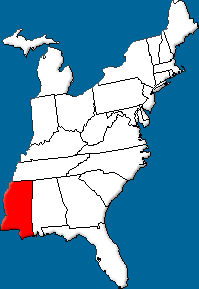 History:
The first European to explore the area that is now Mississippi was Spaniard Hernando De Soto in 1540. De Soto and others were looking for gold. Finding none in the area, they left and did not return. It wasn't until 1682 that a French explorer, Robert Cavelier, Sieur de la Salle clamed the entire Mississippi Valley for his country and named it Louisiana in honor of King Louis XIV.
In 1699, Pierre de Moyne founded the first European settlement in Mississippi at Old Biloxi (now called Ocean Springs) as a French settlement. His brother, Jean Baptiste le Moyne, founded Fort Rosalie (now the site of Natchez) in 1716. The early colonists brought with them black slaves to work in the tobacco, rice and indigo fields, and during the 1700s, settlers began to move to Mississippi.
The native Natchez Indians fought against European settlement, and in 1730, French troops killed nearly every tribe member. However, the French would come into conflict with British troops and settlers vying for territory, and eventually, the Chickasaw Indians allied with the British to drive the French from northeast Mississippi. Following the French and Indian War in 1763, the Treaty of Paris gave England all the land east of the Mississippi River. The current state of Mississippi was then divided into two portions: the southern part became part of the British province of West Florida and the remaining became part of the colony of Georgia.
The Revolutionary War (1775--1783) determined that England's land east of the Mississippi would become part of the new United States. However, Spain had taken over the portion of present-day Mississippi that was in the province of West Florida. Difficulties between Spain and France led to that area again reverting to the French, but in 1803, the US acquisition of the area called the Louisiana Purchase made all the land bordering the Mississippi River part of the United States. At first, the area that includes today's states of Alabama, Mississippi and parts of Florida was known as the Mississippi Territory. In 1817, Mississippi became the 20th state, and the remainder of the territorial area became the Alabama Territory.
During the early years of the nineteenth century, cotton became the major crop in Mississippi. This was encouraged by the invention of the cotton gin in 1793. Slave labor was used to operate large cotton plantations, and by 1860, there were more black slaves than white settlers in the state. The issue of slavery was, therefore, of primary importance in the state. In 1861, Mississippi became the second state to secede from the Union and join the Confederate States of America. Mississippi native Jefferson Davis was the Confederacy's president.
Mississippi became the site of a number of important battles during the Civil War, including the Battle of Vicksburg. The Confederates surrendered Vickburg after a 47-day siege. This gave the Union control of the Mississippi River and was an important turning point in the war. Two years later, in 1865, the war was over. At that point, Mississippi was placed under military control and all slaves were freed. By 1869, the state passed a new constitution granting black people the right to vote, and one year later, Mississippi was readmitted to the Union. The new law did not change the minds of many citizens of the state, and racial discrimination did not end. The drastic change in the state's economy after the end of an agricultural system powered by slave labor left many suffering from poverty. |









